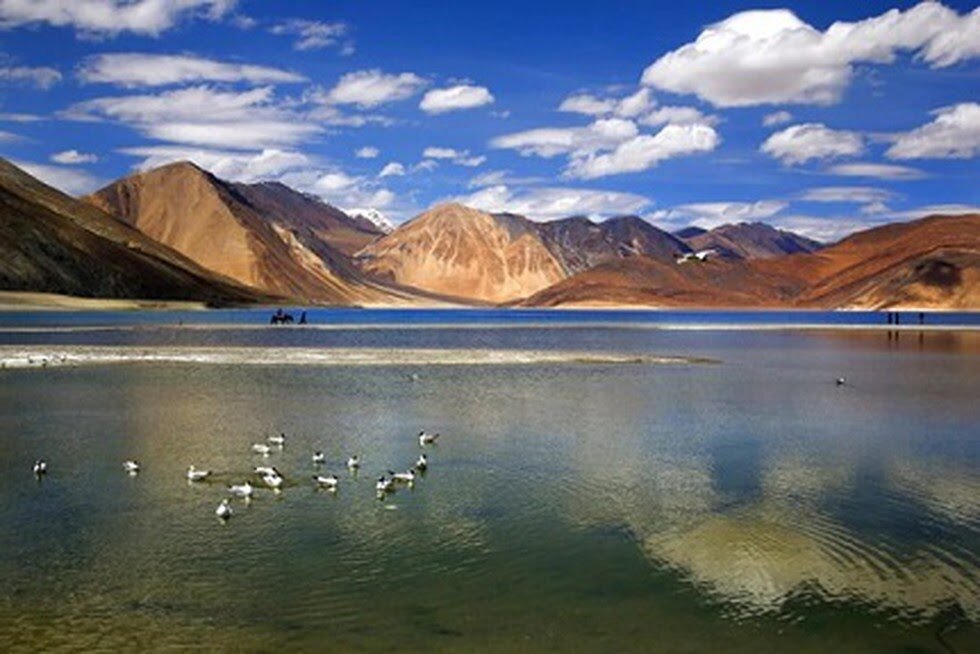Biodiversity & Environment
Ladakh’s Tso Kar Wetland Complex: Ramsar Site
- 30 Dec 2020
- 5 min read
Why in News
Recently, India has added Tso Kar Wetland Complex in Ladakh as its 42nd Ramsar site, a conservation status conferred by International Ramsar Convention on Wetlands.
- Previously, the Lonar lake in Maharashtra and Sur Sarovar (also known as Keetham lake) in Agra were added to the list of Ramsar sites.
Key Points
- About Tso Kar Wetland Complex:
- The Tso Kar Basin is a high-altitude wetland complex, consisting of two principal waterbodies:
- Startsapuk Tso, a freshwater lake of about 438 hectares to the south,
- Tso Kar itself, a hypersaline lake of 1800 hectares to the north, situated in the Changthang region of Ladakh.
- It is called Tso Kar, meaning white lake, because of the white salt efflorescence found on the margins due to the evaporation of highly saline water.
- It is an A1 Category Important Bird Area (IBA) as per Bird Life International and a key staging site in the Central Asian Flyway.
- Important Bird Area (IBA):
- The IBA programme of the Bird Life International aims to identify, monitor and protect a global network of IBAs for conservation of the world's birds and associated biodiversity.
- Bird Life International is a global partnership of non-governmental organizations that strives to conserve birds and their habitats.
- Central Asian Flyway (CAF):
- It covers a large continental area of Eurasia between the Arctic and Indian Oceans and the associated island chains.
- The Flyway comprises several important migration routes of waterbirds, most of which extend from the northernmost breeding grounds in the Russian Federation (Siberia) to the southernmost non-breeding (wintering) grounds in West and South Asia, the Maldives and the British Indian Ocean Territory.
- It covers at least 279 populations of 182 migratory waterbird species, including 29 globally threatened species.
- Important Bird Area (IBA):
- The site is also one of the most important breeding areas of the near threatened Black-necked Crane (Grus nigricollis) in India.
- It is the major breeding area for Great Crested Grebe (Podiceps Cristatus), Bar-headed Geese (Anser Indicus), Ruddy Shelduck (Tadornaferruginea), Brown-headed Gull (Larus Bunocephalus), Lesser Sand-Plover (Charadrius Mongolus) and many other species.
- The Tso Kar Basin is a high-altitude wetland complex, consisting of two principal waterbodies:
- Importance of Wetlands:
- Wetlands are defined as "lands transitional between terrestrial and aquatic eco-systems where the water table is usually at or near the surface or the land is covered by shallow water".
- Wetlands provide a wide range of important resources and ecosystem services such as food, water, fibre, groundwater recharge, water purification, flood moderation, erosion control and climate regulation.
- They are, in fact, a major source of water and the main supply of freshwater comes from an array of wetlands which help soak rainfall and recharge groundwater.
Ramsar Site
- Ramsar Convention on Wetlands is an intergovernmental treaty adopted in 1971 in the Iranian city of Ramsar, on the southern shore of the Caspian Sea.
- It came into force for India on 1st February, 1982.
- Those wetlands which are of international importance are declared as Ramsar sites.
- The Convention’s mission is the conservation and wise use of all wetlands through local and national actions and international cooperation, as a contribution towards achieving sustainable development throughout the world.
- The Montreux Record is a register of wetland sites on the List of Wetlands of International Importance where changes in ecological character have occurred, are occurring, or are likely to occur as a result of technological developments, pollution or other human interference.
- It is maintained as part of the Ramsar List.
- At present, two wetlands of India are in Montreux Record:
- Keoladeo National Park (Rajasthan) and
- Loktak Lake (Manipur).
- Chilika Lake (Odisha) was placed in the record but later removed from it.




